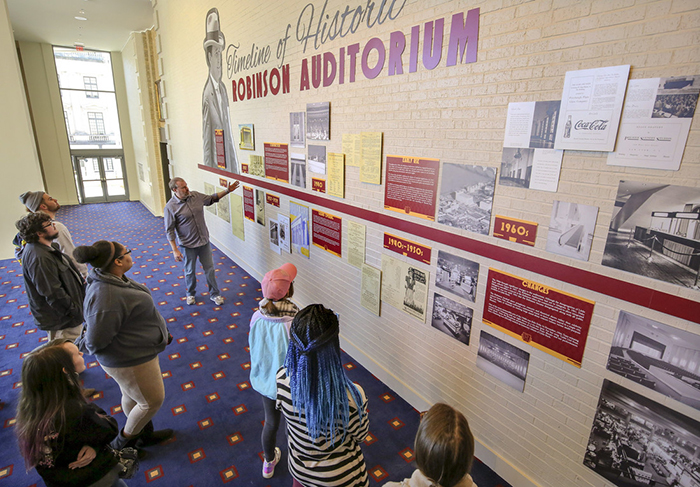History on display
Little Rock’s Robinson Center unveiled a new permanent exhibit on Friday, Nov. 9, that is the result of research and creative work by the University of Arkansas at Little Rock’s Collections and Archives and the Department of Art and Design.
The “Timeline of Historic Robinson Center” was unveiled Nov. 9 at a ceremony in the second-floor Historic Lobby on the east side of the Robinson Center. The exhibit’s opening coincided with the second anniversary of Robinson’s 2016 reopening following an extensive renovation.
The timelines stretches more than 50 feet along the interior wall, detailing the history of the center from the 1930s to the present. At one end of the timeline is a 10-foot-tall photograph of Joseph Taylor Robinson, the former Arkansas governor and U.S. senator for whom Robinson Auditorium was named. At the other end is a reproduction painting of the newly remodeled building that re-opened Nov. 10, 2016, following a 28-month, $70-million restoration, renovation, and expansion led by the Little Rock Convention and Visitors Bureau.
“Anyone who has spent time in central Arkansas has a personal story of Robinson Center,” said Gretchen Hall, president and CEO of the Little Rock Convention and Visitors Bureau. “The facility has touched so many within our community. Maybe you experienced your first symphony concert or Broadway production there; graduated or performed on the stage; or attended a wrestling, boxing, or basketball game in the original basement. The facility has long been a prominent landmark for performing arts and cultural entertainment in Little Rock.”
The exhibit was a collaboration between UA Little Rock’s Archives and Special Collections, Center for Arkansas History and Culture, Department of Art and Design, Department of History, and the Little Rock Convention and Visitors Bureau.
“Our archivists and historians did the research and writing for the historical pieces, and the artists created the visuals and design,” said Deborah Baldwin, associate provost of UA Little Rock’s Collections and Archives. “It’s been a nice match of skills.”
Shannon Lausch, an archivist at the Center for Arkansas History and Culture, was the lead researcher and wrote the primary text panels for the exhibit. Charles Romney, associate professor of history, and Vincent Vinikas, professor of history, also contributed to the research. Kevin Cates and Thomas Clifton, professors in UA Little Rock’s Department of Art and Design, oversaw the exhibit design.
Cates, who teaches graphic arts, oversaw the on-site installation on Oct. 22. He also used the exhibit as a teaching moment for students in his Print Production class, who toured the exhibit. Cates explained the installation process and the inevitable troubleshooting required on a large public exhibit to his class, which includes mainly art and graphic design majors.
Cates also pointed out subtle design elements – the type font, color choices, and repeating art motifs – that mimic the art deco vibe of Robinson Center’s original design.
Planning and design of the project has been in the works for about a year. UA Little Rock’s Collections and Archives hold the archival items used in the exhibit and proposed the permanent exhibit as a way to feature this material about the Robinson Center’s history.
The exhibit details the historical significance of the Robinson Center and the many functions that it has served for nearly a century. The center was born out of the desperate need for work for the jobless in the Great Depression, which struck hard in Arkansas. Little Rock also needed a municipal auditorium. Construction of Robinson Auditorium was one of several building projects made possible under President Franklin Roosevelt’s New Deal legislation.
At the groundbreaking ceremony on Dec. 14, 1937, city officials dedicated the building to Sen. Robinson, who had died six months earlier. The city saw it as a fitting tribute to name the structure after Robinson, whose work in supporting the New Deal had enabled projects like the Robinson Auditorium.
Over the years, Robinson has hosted theater, music, dance, lectures, sports, and civic events. When it opened, it became the first auditorium in the South with air conditioning. Conventions, theatrical shows, and numerous musical acts all came to Little Rock. In fact, the first recording of Elvis Presley’s “Hound Dog” was made on Robinson’s stage.
Robinson also provided a platform for figures of national significance. In 1947, Dwight Eisenhower shared his experiences as supreme commander of the allied forces in World War II. Pres. Harry Truman also spoke and attended a ball at Robinson on June 10, 1949. During their presidencies, Bill Clinton and George W. Bush chose Robinson Center to speak with audiences in Little Rock.
The Robinson Center exhibit is the second permanent exhibit that the UA Little Rock Center for Arkansas History and Culture has completed recently in downtown Little Rock. In 2014, UA Little Rock completed an exhibit for the lobby of the city’s Arcade Building. The exhibit intersperses images of early construction scenes, blueprints, and photographs of the Arcade Building with historical facts about its founders and architects.
UA Little Rock professor Kevin Cates explains some of the design elements of the new “History of Robinson” timeline in Robinson Center to some of his students. Photo by Benjamin Krain
